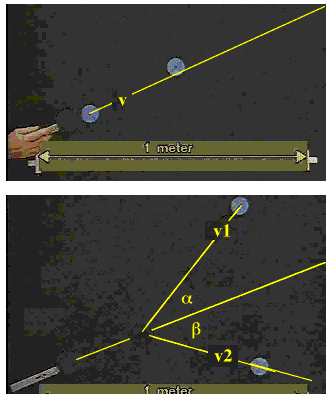In this lab, you will analyze the video of a collision between two pucks on an (almost) frictionless surfaces. Two frames from the video are given below. A projectile puck moving with velocity v collides wiht a target puck of the same mass. The pucks then move along the trajectories shown in the second frame.
From the video you will determine the speeds v, v1, v2 and the angles. How would you use this information to verify conservation of momentum?

2. A ball of mass 1.5 kg with an initial velocity of 12 m/s is rolling up a 30 degree frictionless incline for 12.14 m. Use conservation of energy to find the final velocity of the ball.
3. In the experiment on Friday you will verify the law of energy conservation by releasing a glider along a tilted air track and comparing the change in potential energy of the glider to the change in kinetic energy. The potential energy change will be calculated from the difference in elevation H between two points, the change in kinetic energy will be obtained from a direct velocity determination by the position sensor.
A schematic diagram of the experiment looks like this:

You will be asked to plot the change in kinetic energy versus the change in potential energy for several releases of the glider from different elevations.
Will that graph as a straight line? Why?
What will be the slope of the line?
You may change your mind as often as you wish. When you are satisfied with your responses click the SUBMIT button.





